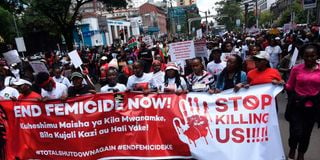Premium
Kenya's worrying femicide statistics exacerbated by victim blaming: Where did we drop the ball?

Women in Nairobi take part in a protest dubbed 'Feminist march against femicide' on January 27, 2024, to protest against the rising femicide across the country in recent months.
The new year began with femicide stories dominating the headlines. Cases of gender-based violence and femicide dominated the news, and the country saw its largest-ever anti-femicide protest, spanning several towns and counties.
When women and feminists took to the streets on January 27, they put into action an online rally that was already underway. Using the hashtags #TotalShutDown, #EndFemicideKE, and #StopKillingUs, Kenyan women rallied their numbers to express their anger at the rising number of deaths at the hands of men. The protests were triggered by a series of murders of women, which attracted a lot of public attention. Femicide, the most extreme form of gender-based violence against women, is the killing of women and girls for gender-related reasons.
According to statistics released last month by the Africa Data Hub, a group of data organisations working with journalists in several African countries, 546 women and girls were killed in Kenya between 2016 and 2023. Femicide Count Kenya, a non-profit organisation, adds that at least 16 women were killed in January 2024, including Scarlet Wahu, an online influencer who was found dead with multiple stab wounds in a short-term rental in Nairobi's South B estate, and Rita Waeni, a 20-year-old university student whose mutilated body was found a week later in another short-term rental in Kasarani, Nairobi.
Following the protests, Amin Mohamed, Kenya's Director of Criminal Investigations, set up a special unit to focus on investigating femicide cases. According to Amin, only 94 deaths of girls and women were reported to the police between 2021 and 2024, and 65 suspects were charged. These figures are worrying when compared to the 725 women and girls murdered in Kenya in 2022 alone, according to the UN Office on Drugs and Crime. On the other hand, Law Society of Kenya president Eric Theuri, who took part in the January 27 protests, says GBV cases take too long to be heard in court, which he says emboldens perpetrators. The reason, he adds, is the inadequate provision of judicial resources, compounded by a shortage of judges, magistrates and prosecutors.
As debates rage over the deaths of many women who are reduced to mere statistics, the prejudice and blame game surrounding their deaths continues to cripple attempts to curb the crime. Public spaces of interaction, especially social media platforms, have not been devoid of statements insinuating that the heinous acts of violence and murder were made possible by the very victims. Mostly in the form of questions, the blame is repeated endlessly and without much thought, and with that, the focus slowly shifts from the criminals to the choices of the victims. No one deserves violence, regardless of the way they dress, their sexuality, the people they associate with, or the way they live.
Every time a victim is blamed, the perpetrator is validated. Victim blaming becomes an attempt to restrict women's and girls' lives when the focus should be on dismantling the structures that breed violence - misogyny and entitlement to women's bodies. Sections of the media have not been at their best in this regard either. Unsolicited speculation only fuels the narratives of blame. Media reports that focus on the way the victim was dressed when she met the man, or that she was accompanied by a man late at night, conveniently perpetuate harmful stereotypes - a woman dressed in a certain way and in a certain place at night deserves whatever happens. Reporting on the crimes also tends to focus on the cruelty of the acts rather than the systemic issues that are at the root of femicide. More often than not, the spotlight is on the horrific details of the crime, with little focus on the system failings that perpetuate crimes against women and femicide.
The focus should be on holding responsible institutions to account. The courts should work to ensure speedy justice for victims, and the media and public forums should work together to amplify the voices of survivors and call out the crime and the perpetrators.





